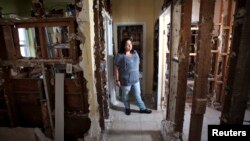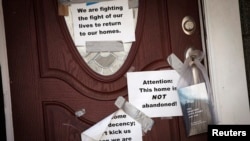A year after Superstorm Sandy wreaked havoc across the eastern United States, only a fraction of the aid money earmarked for recovery has been used, in what some claim is a painfully slow and opaque process.
Only $5.2 billion of the pledged $47.9 billion had been tapped by cities and states by the end of August, according to the U.S. Department of Housing and Urban Development. And tracking those funds has been complicated, lawmakers said.
“Transparency is woefully lacking. We don't know where the money is. We know people have been approved for grants, but the money has not been distributed,” said New Jersey Assemblywoman L. Grace Spencer, chair of the environment committee.
The historic storm killed at least 159 people and damaged more than 650,000 homes when it made landfall on Oct. 29, 2012, devastating parts of New York, New Jersey and other states.
Three months after Sandy, Congress approved a $50 billion relief bill, which automatic federal spending cuts later reduced by 5 percent. It also authorized the National Flood Insurance Program (NFIP) to borrow $9.7 billion to pay for Sandy claims.
The funds flow from the federal government to affected states, which hire contractors or give money to local governments to spend. Recipients as well as those who try to assist them say that accessing the money is exhausting.
“Everyone is so fatigued,” said Joseph Pupello, President of Zone A New York, a non-profit organization formed after the storm. “From the people who need help to the people who are helping.”
At first glance, Nicole and Steve Chati's one-story house in Staten Island's New Dorp Beach looks unscathed. But a rotten foundation makes it a total loss. As the Chatis talk about their problems, a chunk of plaster falls from the ceiling.
“It's been hell. All I have done is fill out paperwork,” Nicole Chati said. “No one comes back to you with an answer.”
They say they're supposed to get $250,000 from their NFIP flood insurance policy, but were offered $100,000 less, not enough to raze and rebuild.
Tracking the money
Officials and watchdogs have struggled to get both sub-contractor level data and a big-picture view of Sandy funding. Local, state and federal officials say they have gone to great lengths to get money out as fast and transparently as possible.
“Red tape is a critical reality that frustrates our impacted residents more than it should. It's awful for those suffering most, and we are working tirelessly to deal with it,” Michael Drewniak, a spokesman for New Jersey Governor Chris Christie, said in an email to Reuters.
Seth Diamond, who is directing storm recovery for New York Governor Andrew Cuomo, said there were many conditions, such as environmental reviews, the state must meet to spend the money.
“We're at the point now where a substantial amount of money is starting to flow and will be flowing. We intend to be very clear about where it's going,” Diamond said.
New York Attorney General Eric Schneiderman has conducted several probes that have led to charges or settlements, many with clean-up contractors and sub-contractors who allegedly didn't pay workers enough, or at all.
Part of the problem in tracking funds is lack of a single source of information. The federal Recovery Accountability and Transparency Board, the watchdog for Sandy funding through 2015, says there is no way to identify Sandy sub-recipients in the clearinghouse for data on federal contracts.
That has also made it tricky for the Board to track down cases of fraud.
“Usually it's not the state or the big city - they don't run off with the money,” said Nancy DiPaolo, a Board assistant director. “It's when it starts getting broken down and down and down. The big question is, who sees that?”
So far, the Board has focused on debris removal and found that some companies hired to do the work had federal and state tax liens. Others had been suspended or debarred from government contracting. Board representatives declined to name the firms.
Addressing the need for some control, New York City Councilman Donovan Richards Jr has spearheaded legislation that would create an online public database that lists Sandy aid details such as recipients, projects and subcontractors.
“It's going to be a long process, but I'm confident it's going to pass,” he said.
Only $5.2 billion of the pledged $47.9 billion had been tapped by cities and states by the end of August, according to the U.S. Department of Housing and Urban Development. And tracking those funds has been complicated, lawmakers said.
“Transparency is woefully lacking. We don't know where the money is. We know people have been approved for grants, but the money has not been distributed,” said New Jersey Assemblywoman L. Grace Spencer, chair of the environment committee.
The historic storm killed at least 159 people and damaged more than 650,000 homes when it made landfall on Oct. 29, 2012, devastating parts of New York, New Jersey and other states.
Three months after Sandy, Congress approved a $50 billion relief bill, which automatic federal spending cuts later reduced by 5 percent. It also authorized the National Flood Insurance Program (NFIP) to borrow $9.7 billion to pay for Sandy claims.
The funds flow from the federal government to affected states, which hire contractors or give money to local governments to spend. Recipients as well as those who try to assist them say that accessing the money is exhausting.
“Everyone is so fatigued,” said Joseph Pupello, President of Zone A New York, a non-profit organization formed after the storm. “From the people who need help to the people who are helping.”
At first glance, Nicole and Steve Chati's one-story house in Staten Island's New Dorp Beach looks unscathed. But a rotten foundation makes it a total loss. As the Chatis talk about their problems, a chunk of plaster falls from the ceiling.
“It's been hell. All I have done is fill out paperwork,” Nicole Chati said. “No one comes back to you with an answer.”
They say they're supposed to get $250,000 from their NFIP flood insurance policy, but were offered $100,000 less, not enough to raze and rebuild.
Tracking the money
Officials and watchdogs have struggled to get both sub-contractor level data and a big-picture view of Sandy funding. Local, state and federal officials say they have gone to great lengths to get money out as fast and transparently as possible.
“Red tape is a critical reality that frustrates our impacted residents more than it should. It's awful for those suffering most, and we are working tirelessly to deal with it,” Michael Drewniak, a spokesman for New Jersey Governor Chris Christie, said in an email to Reuters.
Seth Diamond, who is directing storm recovery for New York Governor Andrew Cuomo, said there were many conditions, such as environmental reviews, the state must meet to spend the money.
“We're at the point now where a substantial amount of money is starting to flow and will be flowing. We intend to be very clear about where it's going,” Diamond said.
New York Attorney General Eric Schneiderman has conducted several probes that have led to charges or settlements, many with clean-up contractors and sub-contractors who allegedly didn't pay workers enough, or at all.
Part of the problem in tracking funds is lack of a single source of information. The federal Recovery Accountability and Transparency Board, the watchdog for Sandy funding through 2015, says there is no way to identify Sandy sub-recipients in the clearinghouse for data on federal contracts.
That has also made it tricky for the Board to track down cases of fraud.
“Usually it's not the state or the big city - they don't run off with the money,” said Nancy DiPaolo, a Board assistant director. “It's when it starts getting broken down and down and down. The big question is, who sees that?”
So far, the Board has focused on debris removal and found that some companies hired to do the work had federal and state tax liens. Others had been suspended or debarred from government contracting. Board representatives declined to name the firms.
Addressing the need for some control, New York City Councilman Donovan Richards Jr has spearheaded legislation that would create an online public database that lists Sandy aid details such as recipients, projects and subcontractors.
“It's going to be a long process, but I'm confident it's going to pass,” he said.








